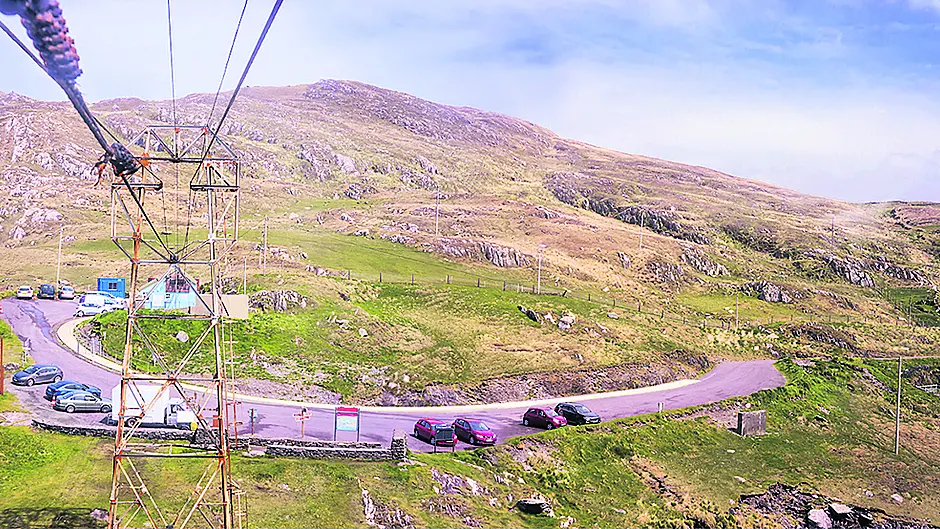At the end of last year, Cork County Council and Fáilte Ireland announced plans for the new Dursey cable car project. Up to now, Ireland’s only cable car has carried a maximum of 18 passengers per hour from the tip of the Beara peninsula to Dursey. The new project could cater for around 80,000 visitors per year. It has drawn support and derision in equal measure, here are two differing opinions
THE CASE AGAINST What is the point of bringing throngs to an island that’s loved for its tranquility, asks Nicole Quint
CORK County Council and Fáilte Ireland have big plans for Dursey Island. The new concept would allow for up to 300 visitors an hour arriving on the island.
Plans also include a visitor centre with a café and outdoor terrace, souvenir shops and plenty of parking. Future prospects that will inevitably make anyone who has ever been to Dursey Island think twice.
Those who once floated with the old cable car over the roaring water to the shining rocks of Dursey could feel a little heroic as the wind strongly shook the angular blue-white cabin.
In an emergency, cable car driver Paddy could be reached via an outdated intercom system.
The ultra-modern new cable cars will hardly tickle the nerves, and Dursey Island itself is about as exciting as a life in a monastery.
There are no pubs, shops or restaurants on Dursey. The chance of meeting warblers, choughs, fulmars and oystercatchers is many times higher than meeting humans.
What is the point of 80,000 visitors on an island that only delights people who are gifted for silence? People who need nothing but landscape and weather.
The melancholy of this ghostly empty island is not for tourists who are dependent on animation and shopping culture and who are already stressed by the non-functioning of their smartphones.
For such travellers, it is not Dursey that is the attraction, but the cable car, and with it they can be lured like guinea pigs with the rustling of a hay bag.
Impact assessment studies for the new cable car project assume that the loss of habitats of rare plants and the disappearance of breeding and sleeping places of some bird species can be expected. It is paradoxical that the new visitor centre is now intended to explain exactly that biodiversity on the island, which is further endangered by the project itself.
While other holiday destinations are now vehemently opposed to over-tourism, Ireland is celebrating the future overcrowding of a remote island.
But the proponents of the project have not yet finally won.
An Bord Pleanála recently postponed the final arbitration award until autumn 2020 and requested further documents. One can only hope that the ridiculously high numbers of visitors will be trimmed and Dursey’s birds will be effectively protected.
Or will thousands of tourists soon be rubbing up against each other at the cable car terminals during the peak season like commuters on a rushour railway?
Depending on the outcome of the decision, travellers to Ireland in the future will be faced with the question of whether one’s own presence in such a beautiful but sensitive place as Dursey is even desirable.
• Travel writer Nicole Quint’s first visit to Dursey Island resulted in an article for German newspaper Die Welt which was awarded a journalism prize from Tourism Ireland in 2017. For more see: www.quint-und-quer.de
This may be the last chance to avail of supports for the plan
THE CASE FOR In a post-Covid world, the beauty and serenity of Dursey will lure visitors and boost the economy of Beara, says Dermod Dwyer
TWO weekends ago in Allihies we booked the Dursey island boat trip online…..what an experience – an historic adrenaline rush! We travelled on a specially-fitted RIB from Garnish though Dursey Sound, under the existing cable car, and around the island out to the Bull Rock and the nearby Cow and Calf islands – skippered by the inimitable Paul O’Shea. Unforgettable. Unmissable.
This trip brought back to mind our first trip out to Dursey on the then multi-purpose cable car, 26 years ago. A trip for all the senses – followed by an idyllic day on Ireland’s only offshore island served by a cable-car.
Driving back to Dublin recently I began to muse on the Covid-19 crisis grinding Irish tourism to a virtual standstill. I remembered when I first started in the hospitality business over 40 years ago. For me one leader and torchbearer stands out.
The man who ignited the flame and belief that we along the western seaboard of Ireland could change was undoubtedly the founder of Shannon Airport, and the world’s first Duty Free shops and the Duty Free Industrial Zone – the late Brendan O’Regan. He was a true visionary who knew there was no point in just having an airport or creating industrial jobs – you also had to develop, incubate and encourage authentic tourism products along the west to entice visitors to stay over.
Even during the Troubles, tourism continued, albeit very slowly. If you lived in Milwaukee or Milan, would you feel safe coming to a small island in the Atlantic? But yet the image of Ireland as an environmentally clean, underpopulated island in the Atlantic with safe food was really strong – the attributes which helped create and sustain the Kerrygold brand, even now.
The idea to continue to develop authentic local attractions ever since has spread tourism up and down the coast and into the midlands to a point where Irish Tourism now sustains over a quarter of a million jobs.
The extraordinary success of joining the dots … and creating the brand Wild Atlantic Way must go down in our industry as our Kerrygold. It has allowed the entire west coast and its attractions to develop, thrive and collaborate to become perhaps Europe’s most sought-after experience.
I strongly believe that in a post Covid-19 world what we have along the west coast is going to be priceless. Space, healthy fresh air, things to do and above all our innate Irish hospitality will trump any other European destination. These experiences will attract a real economic premium.
Beara has really been the less promoted peninsula … rugged, breathtakingly beautiful, with only the south-west fishing capital in Castletownbere as the main source of employment.
The Beara Way walking trails are world class. So much more to see and do. But the area still requires the last piece of the jigsaw to become sustainable in a measured and appropriate way … and that last piece is now in final phases on the planning permission approval process: the upgrading of the Dursey Cable Car and related works.
It’s a small development, a stunning proposal and a fit-for-purpose and fit-for-place project.
It has the full backing and funding from Cork County Council and Failte Ireland. I genuinely fear that the opportunity could pass.
Given the time we are now in, this capital grant support may never again be on offer. The success of the enterprise, the jobs and the confidence it will engender will foster micro-tourism support businesses all around the area. The cable car can anchor a growing cluster of authentic magnets to encourage post-Covid visitors to come to Beara and ‘tarry a little while longer’.
I really hope this project goes ahead. It can make a real difference to Beara and enhance the Wild Atlantic Way.
• Dermod Dwyer is a former international tourism consultant and currently executive chairman of the Convention Centre Dublin, a director of Powerscourt Estate and Gardens, and a past president
of the Irish Hotels Federation.








